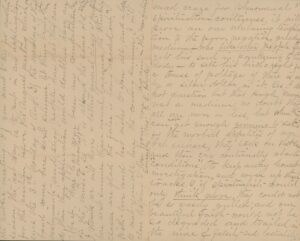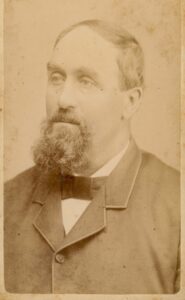



Julia Hyde Letter, 1896. 2007.017.1
A letter dated April 25, 1896, from Mrs. Julia E. Hyde to Mrs. Mary Grey Peck. Consists of four pages of paper broken up into eight handwritten sections. As the context of this case study is Victorian spiritualist beliefs the following transcription is of that content only, the personal content has been left out. Julia’s transcribed comments about her spiritualist beliefs are as follows:
“I do not anticipate that the cloud shadowing Lily Dale will be permanent. I hope it will result in a wholesome weeding out of fraud, and “ringing in of the true”. I do not question the mediumship for many of these people, but their greed of gain prompts them to descend to actions that true spiritualists cannot condone nor sanction. But that does not do away with the real in our cause. I do not, and never did believe that physical manifestations are the basis of spiritual belief. How can material things prove spiritual things, when they are diametrically opposed to each other in expression? I think the great danger to our cause lies in the physical manifestations…and in the long run make more skeptics than believers…How sad to think there are so many gross, animalistic, drunken, debauched mediums trying to represent our cause, and getting so large a following too among many dear good people who allow their emotions to get the better of their reason and in their allegiance to their spirit friends as they believe fail to see that they are being duped sadly often times. I believe in mediumship. I believe we have some good honest souls who come in rapport with spirit entities; but for most of the commercial mediumship I have but little regard or respect. Christ and the apostles who were the finest mediums the world has ever known did not sell their spiritual gifts at so much per item… I don’t believe true spirituality can be bought and sold either by the ounce or by the ton and just so long as this mad craze for phenomenal spiritualism continues, it will prove an overwhelming temptation to the poor, negative, greedy medium who like other people forgets his soul in pandering to his body…Yes I do not question but that Hugh Moore was a medium; no doubt they all are more or less, but when they cannot get enough genuine to satisfy the morbid appetites of marvel suckers, they back on the false and then cry continually about “conditions” to keep away honest investigation and cover up their tricks…Just think of his being an “ordained minister” according to one of the fooleries that has been tacked on to our faith by too indiscriminate admiration of physical mediumship…May all wise power, brought into action by the highest, holiest efforts of our spirit friends and assistants who have risen above earth bound conditions hasten the day when we as believers in immortality shall rise enfranchised into the god realm of spiritual unfoldment instead of struggling in pain sorrow and doubt in the valley of physical phenomena… I am a firmer spiritualist to day than ever before, because of my hope that false conditions are passing out, and being overcome and the genuine will triumph at last.”1
One of the most notable houses at the GCV&M is the “Octagon House”, or as it is properly called, “Hyde House”. Being in the shape of an octagon, the house immediately becomes one of the most interesting focal points in the “gas light district” of the village. But, the lives of the couple who built and lived in the house are just as interesting.
Julia Evelyn Watson was born on July 12, 1845, in Allegany County, New York, to Oliver Watson and Angelica Harris. She received a degree from the Allegany Academy of Music in Friendship, New York, in 1869 and was a music teacher for many years. Her diploma can be seen hanging on the wall in the sitting room at Hyde House. She was also an ordained Methodist minister.
Erastus C. Hyde was born on February 25, 1844, in Friendship, New York, to Jesse Hyde and Lucinda Moss. In 1862, at the age of 18, Erastus joined the Union Army, NY 136th, as a drummer boy and served until 1865. He married Julia ca. 1870 and they built their octagon house shortly after in Friendship, New York. They lived for a time in Virginia where, according to the 1880 Federal Census, Julia was a music teacher and Erastus was a collector for the Internal Revenue Service. They then moved to Pennsylvania where in 1884 Erastus earned a medical degree from the Homeopathic Medical College of Pennsylvania, (now the Hahnemann Medical College of Philadelphia.) He was a homeopathic physician and had practices in Friendship and Lily Dale, New York.
The Hyde’s never had biological children, but they did have adopted children although it is not known if they were official adoptions. They took in children and gave them an education, with the two known children being Martha Patram, age 10, when they lived in Virginia in 1880 and Cecil Hyde, age 13 in 1910 when they lived near Lily Dale, New York. Cecil was born in Florida and as the Hyde’s often wintered there it is likely that is where they met him. Although they lived in many places the Hydes never sold their octagon house in Friendship. They loved music and each had a violin, and they would sit on the porch in the evenings and play together. One of these violins still exists and can be seen in the sitting room in Hyde House at the GCV&M.
For the last months of their lives the Hyde’s lived with a family in Pennsylvania. It is not known how they came to know each other, but they are listed as boarders in the 1930 census. Erastus Hyde died on January 7, 1931, and two days later, only just hours before his funeral, Julia passed away as well.
As the above letter shows, Julia Hyde and her husband were Spiritualists. They mention this when you tour Hyde house but what does this mean to them? What did Spiritualism look like during this time period and what did the Hydes believe?
The first half of the 19th century saw a “Great Revival” sweep the United States. With the creation and completion of the Erie Canal, Western New York had an influx of people with many different beliefs. “This fast-moving wave of spirituality and religious zeal, which converted so many so quickly, prompted observers to refer to the Genesee Valley as the ‘Burned-Over District.’”2 Rochester was a very liberal city in the mid-1800s open to many new religions, with practically the only forbidden thing being atheism. This means when the infamous Fox sisters, who lived just outside Rochester, heard “knocking” coming from their dining room when they sought to ask spirits questions, it wasn’t so strange for so many in the area to grasp at the idea. This was in fact what most people see as the birth of the Spiritualism movement in the United States.
Enter the “Victorians”. Victorians in the United States were not just people who lived in a specific time period but can also be seen as a social class. They were, for the most part, the rising middle class aiming for respectability and who wanted to set themselves apart from the “working class”. They had a high moral compass taken from cues given by Queen Victoria of England. They are thought of as having been hopeless romantics, and above all, extremely sentimental, especially about death. Elaborate customs and rituals and defined periods of public mourning and the personal aspect of death, such as preparing the body for burial, ruled Victorian life. There were rules for “dying” and for having a “good death”.
Then the latter half of the 19th century saw war. Both the Mexican American War and the Civil War saw devastating loss of life and on many occasions the body of the lost never made it home. For some, Spiritualism filled the void left by the horrors and loss of war. In addition, the Victorians had a different view of heaven from previous centuries. “Heaven became a domesticated haven; it no longer held the terror of a dreadful last judgement.”3 Talking to “Spirit Friends” beyond the veil was not too far of a leap to make.
The Hydes fully embraced Spiritualism. They became members of the Spiritualist community of Lily Dale, New York, with Erastus serving on the board of trustees. It is still known as one of the most important Spiritualist hubs in the United States. In 1894 the Hydes, along with other members of the Lily Dale community, purchased real estate and chartered the “Southern Spiritual Association” in Magnolia Bluff, Florida, just outside of Pensacola, to serve as a Spiritualist camp and for the purpose of the “promotion of religion and morality among men, [and] the making of provision for literary and scientific education through propagandism of the philosophy and religion of Spiritualism.”4 Erastus served as the treasurer. The activities of the camp are not known, and the camp was dissolved in 1936.
The Spiritualist followers were not without sceptics. At the time that Julia wrote her letter there was intense scrutiny and many accusations of fraud. Julia speaks of holding true to her faith and vehemently renouncing fraudsters. She, like many other followers, abhorred the thought of fraud and believed that spiritualism was not a commercial endeavor. The most frequent questions interpreters get at Hyde House is, “Is it haunted?” and “Did they have seances here?” This has long been debated by staff and visitors alike. I have spent many hours inventorying objects in Hyde House and aside from a hilarious and slightly terrifying moment when we didn’t realize an interpreter was in the house, found no claims of the supernatural to be true.
But what is most important is the view that the Hyde’s had. As one can see from Julia’s letter this goes against all her beliefs. She is steadfastly against the thought of any physical manifestations such as “ghosts”. Talking to “Sprit Friends” for Julia meant speaking to those through the veil. She was speaking to those who had passed on to Heaven, not bringing them into the physical world, and she did this by looking inward, being almost in a meditative state to do this. And while they most likely did have Spiritualist meetings in the house, I believe Julia would have balked at the idea of not only the thought of bringing “ghosts” forth but also the thought of having them trapped there. So, while it might be a letdown to visitors, (ghost stories can be fun), it is important to present the facts and the beliefs of the original owners of the house.5


Julia Evelyn Watson Hyde, ca. early 1880s. 86.27.2
Erastus Hyde, ca. early 1880s. 86.27.3
- Julia E. Hyde to Mary Grey Peck, “Julia Hyde Letter to Mary Grey Peck” (Lily Dale, New York, April 25, 1896). ↩︎
- “The Burned-Over District,” The Burned-Over District | New York Heritage, accessed April 1, 2024, https://nyheritage.org/exhibits/two-hundred-years-erie-canal/burned-over-district. ↩︎
- Thomas J. Schlereth, Victorian America: Transformations in Everyday Life, 1876-1915 (New York, New York: Harper Collins, 1991). ↩︎
- Newspapers.com. The Pensacola News, September 21, 1894. https://www.newspapers.com/article/the-pensacola-news/132429383/. ↩︎
- Some of the information here I learned and have paraphrased from a lecture I attended in October of 2023 by Derek Maxfield, Professor of History at Genesee Community College, titled “Victorians and Spiritualism”. ↩︎



